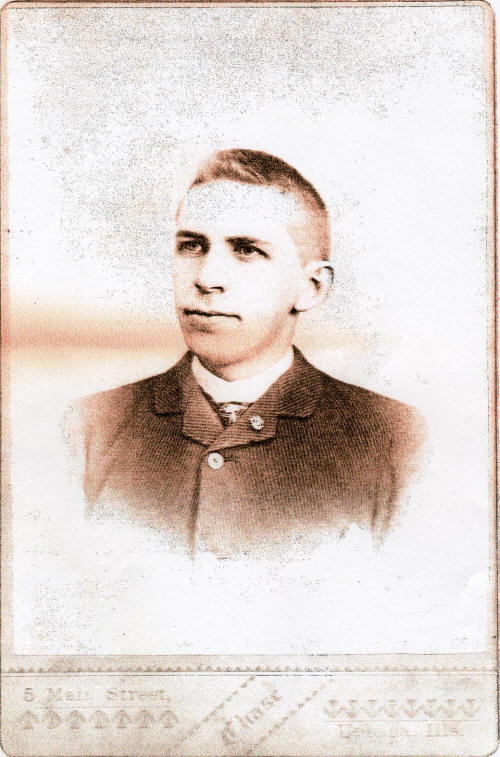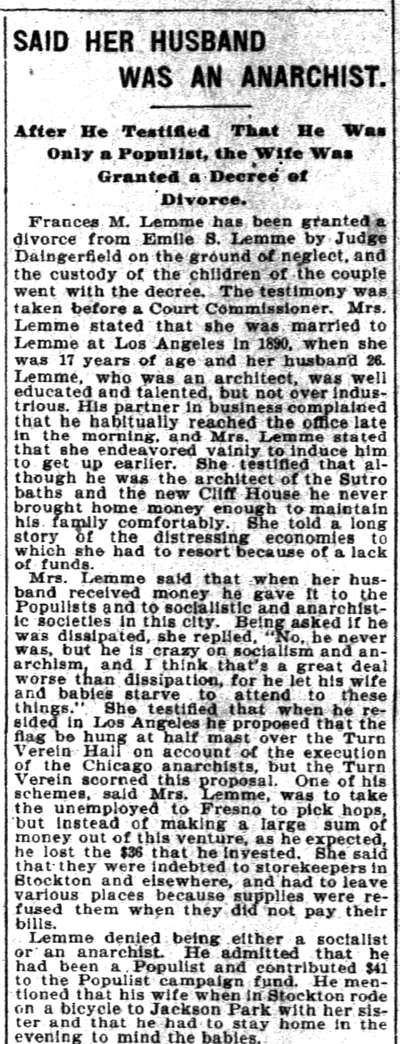Emil S Lemme
Researcher by: Desmond Smith
desmo445@hotmail.com

Emil S Lemme (reverse)
| Emil S Lemme (1863 – 1921) This is a photo of Emil S Lemme. It
was taken in May 1886 probably on the day of his graduation with a
diploma in architecture and engineering from the Industrial
University of Illinois at Urbana, Champaign (now the University of
Illinois). He is 23 years old and has had an unusual life.
His mother, Emilie (Lemme) Schroeder died a few days after he was born in 1863 in Davenport, Iowa. His father, Johannes C Schroeder already had several sons and the infant Emil was adopted by his mother’s brother, Edward Lemme and his wife Henrietta. Emil’s biological parents and his adopted parents had migrated from Northern Germany in the 1840’. In the US they joined up with a community of Utopian idealists (Icarians) founded by the French radical and visionary, Etienne Cabet. This group formed a succession of socialist communes initially in the South but latterly in the Midwest, notably in Cheltenham, Missouri; Nauvoo, Illinois; and Corning, Iowa. Though the Schroeders continued to live within the Icarian communities (they were known for their decorating, sign-painting and frescoing skills), Emil and his adopted parents soon moved permanently to Davenport which at that time was a thriving Mississippi river port with a large German population. Emil attended school there until 1882 when he entered the Industrial University of Illinois at Urbana-Champaign. At University, he was a pupil of Professor Nathan Clifford Ricker. Ricker has the distinction of being the first person in the USA to acquire a university diploma in architecture. His teaching approach stressed practical technical knowledge and drew much inspiration from the German and Russian traditions of architectural education rather than the French Ecole des Beaux Arts approach that was in vogue at MIT and other schools on the east coast. Ricker is now credited with significant influence on the Chicago School of Architecture. Emil graduated in the class of 1886 and went to work as an architectural draftsman with a number of firms in Chicago, Los Angeles and San Francisco. He quickly established himself as an outstanding talent. In early 1891, he set up his own practice in San Francisco working in partnership with Charles J Colley (1850-1928). In a letter to Ricker from Lemme dated 10th February 1892, Lemme describes his career in the six years after graduation; “I am very happy to be able to state that the instructions I received from you and our university were the source of the many successful designs that I made in the course of years that I worked in Los Angeles and San Francisco……..Since I am in business for myself I have been the successful competitor for three large competitions. The City Hall in Woodland, California; TurnVerein Hall in this City {San Francisco} and last but not least the Sutro Baths………So far I was successful in every competition that I undertook. I have made personally every and all drawings for these competitions without the aid of others.”* Colley and Lemme continued in partnership until 1895. Their most important client, Adolph Sutro – for whom they had designed the Sutro Baths (the world’s largest sea-water baths) and later the Cliff House in 1895 as well as other smaller projects - died in 1896. The subsequent career of Emil Lemme is something of a mystery. From 1896 to 1902, there is no listing for Lemme in the San Francisco City Directory but he reappears in 1903 and continues to be listed as an Architect working under his own name at various addresses until his death in November 1921. However there is very little sign of any projects undertaken by Lemme in the latter half of his career. The likely explanation is that he worked primarily as a structural engineer on projects that were led by other architects and so was not publicly credited. Though he grew up separated from his biological father and siblings, there is evidence that both of Emil’s families remained in close contact with each other (and with their relatives in Germany). The Schroeders remained part of the Icarian communes until the early 1870’s. Following a severe attack of rheumatism, the father J C Schroeder decided to migrate to California in 1874 and set up business with two of his sons in Los Angeles. A contemporary account states that “their skill won for them almost immediate recognition” and quickly “worked up one of the largest sign and fresco trades in southern California.” The father died in 1892. Lemme’s oldest brother, William Schroeder, who also grew up in the Icarian settlements moved to San Francisco and set up the California Art Glass Works which was said to be the leading West Coast manufacturer of art glass in the late 19th Century/ early 20th Century. Among the surviving works are St John’s Presbyterian Church in San Francisco (corner of Lake and Arquello) and the First Baptist Church of Oakland on 22nd street . On a personal note, Emil had two marriages; the first to Francis Krumdick in 1890 in Los Angeles; the second to Amy Alberta Eskew in San Francisco in 1901. He had two children from his first marriage. Like all of the Schroeders, Lemme maintained a life-long involvement with German fraternal organizations and at various times held prominent offices in the Turnverein and the Independent Order of Foresters. He is buried in Forest Hill Cemetery in Oakland California along with his second wife who survived him by many years. She, Alberta Lemme O’Connell, died in 1946 and is buried alongside Emil. Descendents of Lemme and Schroeder remain in California. Recently German scholars have uncovered a trove of letters written by the Schroeder and the Lemme families to their relatives in Germany describing their life in the New World. These letters form the basis of the massive book “Etienne Cabet und seine Ikarische Kolonie” by Hoppner and Seidel-Hoppner, published in Germany in 2002. The letters are said to be touching and reveal “an admirable spirit of idealism, enterprise, and resilience. Despite many setbacks, they never lost their optimism, enthusiasm and sense of humor.” Desmond Smith desmo445@hotmail.com The writer would be pleased to hear from anyone who can shed further light on Emil Lemme or his remarkable family. * Ricker papers, University of Illinois Archive Urbana-Champaign |

San Francisco Chronicle - Sep 6 1900
Divorce Announcement